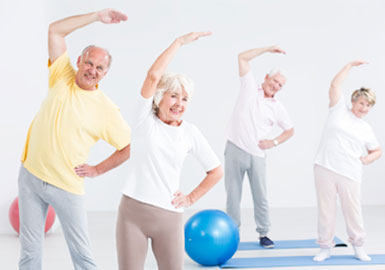 One of the most important things people of all ages can do for their health is getting regular exercise. Moving more and sitting less will go a long way in improving your health. Exercise is an integral component of a healthy lifestyle. This applies to even older adults, but it is common to see seniors lose their health and balance when they age.
One of the most important things people of all ages can do for their health is getting regular exercise. Moving more and sitting less will go a long way in improving your health. Exercise is an integral component of a healthy lifestyle. This applies to even older adults, but it is common to see seniors lose their health and balance when they age.
Regular exercise can provide substantial health benefits for adults age 65 years and older. Being physically active makes it easier to perform daily activities such as eating, bathing, toileting, dressing, getting into or out of a bed or chair, and moving around the house or neighbourhood, without any help. Physically active older adults are less likely to experience falls, and if they do fall, they are less likely to be seriously injured.
The Department of Health and Human Services issued the federal government’s first-ever Physical Activity Guidelines for Americans in 2008 to help Americans understand the types and amounts of physical activity that offer important health benefits. The key guidelines just for older adults are as follows:
- As part of their weekly physical activity, older adults should do multicomponent physical activity that includes balance training as well as aerobic and muscle-strengthening activities.
- Older adults should determine their level of effort for physical activity relative to their level of fitness.
- Older adults with chronic conditions should understand whether and how their conditions affect their ability to do regular physical activity safely.
- When older adults cannot do 150 minutes of moderate-intensity aerobic activity a week because of chronic conditions, they should be as physically active as their abilities and conditions allow.
According to Healthline, older adults should use their level of fitness to determine the effort for physical activity. For example, on a scale of 0 to 10, where sitting is 0 and 10 is maximum effort, moderate-intensity activity is a 5 or 6. At this level, you should be able to talk, but not sing, during the activity.
But now, new guidelines have been introduced that provide specific suggestions for certain age groups. The U.S. government has updated its guidelines for regular physical activity for the first time in ten years, notes Harvard Health. The guidelines, published in the Nov. 20, 2018 issue of JAMA, still suggest adults get at least 150 to 300 minutes each week of moderate-intensity physical activity (such as brisk walking, swimming and cycling), and the more you can do, the better.
The new guideline report recommends mainly two things for older adults:
- Incorporating recreational activities like dancing, yoga, tai chi, gardening, or sports often along with multi component activities (balance training, aerobic exercise, and muscle strengthening) all of which can help older adults reduce their risk of falls.
- A change in time you should exercise per workout. Previously, sessions had to last at least 10 minutes to count toward your weekly quota. But now researchers suggest that any duration is fine, and the focus should be on consistency. For instance, even small bouts of activity like taking the stairs instead of the elevator, all can contribute to your weekly activity.
It is never too late to start being physically active. Physically active older adults are less likely to experience falls, and if they do fall, they are less likely to be seriously injured. Physical activity can also preserve physical function and mobility, which may help maintain independence longer and delay the onset of major disability. Research shows that physical activity can improve physical function in adults of any age, adults with overweight or obesity, and even in those who are frail. Promoting physical activity and reducing sedentary behavior for older adults is especially important because this population is the least physically active of any age group, and older adults spend a significant proportion of their day being sedentary. So try to break up long periods of sitting with light activity, as sedentary behavior is now considered an independent risk factor for ill health, no matter how much exercise you do.
However, older adults with chronic conditions should talk or consult with their health care professional to determine whether their conditions limit, in any way, their ability to do regular physical activity. This would help them learn about appropriate types and amounts of physical activity they can perform.
